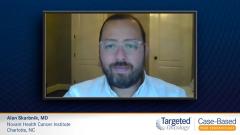
Follicular Lymphoma: The GALLIUM Study
Dr. Alan Skarbnik reviews the use of obinutuzumab-based therapies for follicular lymphoma and highlights data from a phase III study.
Alan Skarbnik, MD: The GALLIUM study evaluated different anti-CD20 antibody strategies for patients with newly diagnosed follicular lymphoma. Centers could choose their chemotherapy backbone: bendamustine, CHOP [cyclophosphamide, doxorubicin, vincristine, prednisone], or CVP [cyclophosphamide, vincristine, prednisone]. Patients would then be randomized to use that chemotherapy backbone with either rituximab or obinutuzumab, and after 6 cycles of induction, patients would then receive 2 years of maintenance with the same anti-CD20 antibody they received in induction. The goal was to address changes in PFS [progression-free survival].
The study did meet the primary end point of improved progression-free survival, favoring obinutuzumab over rituximab. However, the improvement in the hazard ratio was different between younger patients and older patients. In patients particularly over the age of 65, the difference between obinutuzumab and rituximab was not as pronounced in terms of PFS. Those patients, particularly the ones who received bendamustine as a backbone, experienced more grade 3 to 5 infections during the maintenance period of obinutuzumab.
In other analyses trying to differentiate between the backbones of therapy, it seemed that patients who received bendamustine and received obinutuzumab as the anti-CD20 monoclonal antibody, the effect of an improvement in PFS was actually more pronounced than for the patients who received CHOP or CVP as the backbone, with a confidence interval across the 1 mark. It is questionable if obinutuzumab does improve PFS in patients receiving CHOP or CVP as a backbone. But again, patients receiving bendamustine have higher risk of infections in the maintenance phase. These are things that need to be discussed with the patient.
I have used obinutuzumab-based therapy for follicular lymphoma, particularly with bendamustine as the backbone, in young patients, patients younger than 60. I do have a discussion with these patients. Patients do prefer having the maintenance therapy because of the PFS gain, again making sure that it is understood that there is no overall survival gain.
In older patients, the discussion is a little bit different because there is a higher concern for infections in the maintenance phase. Some patients do prefer having maintenance at that point may consider having particularly prolonged antiviral prophylaxis. But during the pandemic, again, I do have concerns for ongoing maintenance with an anti-CD20 given the decreased efficacy of COVID-19 vaccines in this patient population. We have to have the discussion with patients in this age to address that issue as well, beyond just the outcomes and survival versus nonsurvival.
Transcript edited for clarity.
A 60-Year-Old Man with Follicular Lymphoma
Initial presentation
A 60-year-old man presents with a 4-month history of fatigue, decreased appetite, occasional fevers, and a 7-lb unintentional weight loss
PMH: Unremarkable
PE: palpable right axillary lymph nodes, ~2.5 cm and bilateral cervical lymph nodes, ~3 cm, spleen palpable 4 cm below left costal margin
Clinical workup
Labs: ANC 1.6 x 10^9, WBC 11.4 x 10^9, lymphocytes 42%, HB 9.7 g/dL, plt 97 x10^9, LDH 402U/L, 3.4 B2M ug/mL; HBV negative
Excisional biopsy of axillary lymph node on IHC showed CD20+, CD3+, CD5+, BCL2+, Follicular lymphoma grade 2
Bone marrow biopsy showed paratrabecular lymphoid aggregates, 38% involvement
Cytogenetics: t(14:18) (Q32;q21)
Molecular testing: EZH2 wild type
PET/CT showed right axillary, bilateral cervical, and mediastinal lymphadenopathy (3.1 cm, 3.1 cm, and 2.6 cm respectively)
Ann Arbor Stage IV, ECOG PS is 1
Treatment
Patient was treated with obinutuzumab plus cyclophosphamide, doxorubicin, vincristine, and prednisone (CHOP) chemotherapy. He completed 6 cycles and treatment was well tolerated.
He continued on obinutuzumab maintenance.
19 months later, he complains of fevers, chills, and worsening fatigue.








































